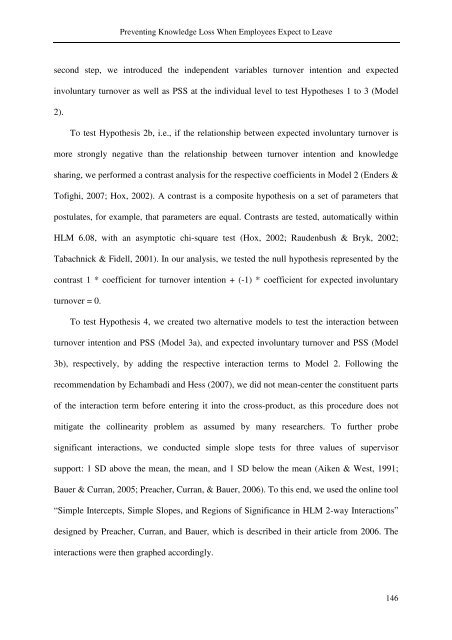thesis_Daniela Noethen_print final - Jacobs University
thesis_Daniela Noethen_print final - Jacobs University
thesis_Daniela Noethen_print final - Jacobs University
Create successful ePaper yourself
Turn your PDF publications into a flip-book with our unique Google optimized e-Paper software.
Preventing Knowledge Loss When Employees Expect to Leave<br />
second step, we introduced the independent variables turnover intention and expected<br />
involuntary turnover as well as PSS at the individual level to test Hypotheses 1 to 3 (Model<br />
2).<br />
To test Hypo<strong>thesis</strong> 2b, i.e., if the relationship between expected involuntary turnover is<br />
more strongly negative than the relationship between turnover intention and knowledge<br />
sharing, we performed a contrast analysis for the respective coefficients in Model 2 (Enders &<br />
Tofighi, 2007; Hox, 2002). A contrast is a composite hypo<strong>thesis</strong> on a set of parameters that<br />
postulates, for example, that parameters are equal. Contrasts are tested, automatically within<br />
HLM 6.08, with an asymptotic chi-square test (Hox, 2002; Raudenbush & Bryk, 2002;<br />
Tabachnick & Fidell, 2001). In our analysis, we tested the null hypo<strong>thesis</strong> represented by the<br />
contrast 1 * coefficient for turnover intention + (-1) * coefficient for expected involuntary<br />
turnover = 0.<br />
To test Hypo<strong>thesis</strong> 4, we created two alternative models to test the interaction between<br />
turnover intention and PSS (Model 3a), and expected involuntary turnover and PSS (Model<br />
3b), respectively, by adding the respective interaction terms to Model 2. Following the<br />
recommendation by Echambadi and Hess (2007), we did not mean-center the constituent parts<br />
of the interaction term before entering it into the cross-product, as this procedure does not<br />
mitigate the collinearity problem as assumed by many researchers. To further probe<br />
significant interactions, we conducted simple slope tests for three values of supervisor<br />
support: 1 SD above the mean, the mean, and 1 SD below the mean (Aiken & West, 1991;<br />
Bauer & Curran, 2005; Preacher, Curran, & Bauer, 2006). To this end, we used the online tool<br />
“Simple Intercepts, Simple Slopes, and Regions of Significance in HLM 2-way Interactions”<br />
designed by Preacher, Curran, and Bauer, which is described in their article from 2006. The<br />
interactions were then graphed accordingly.<br />
146

















